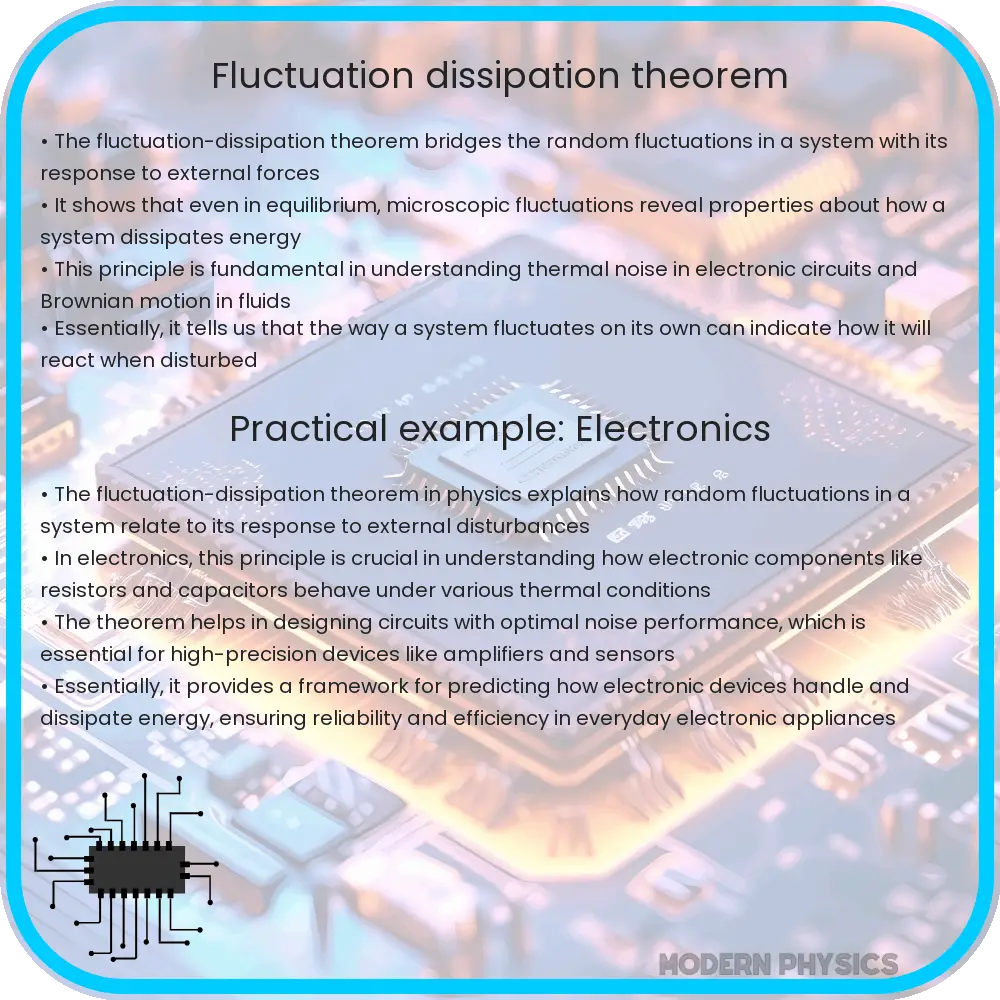Explore the Fluctuation-Dissipation Theorem in statistical thermodynamics, its key concepts, applications, and impact on understanding physical phenomena.

Understanding the Fluctuation-Dissipation Theorem in Statistical Thermodynamics
The Fluctuation-Dissipation Theorem (FDT) is a fundamental principle in statistical thermodynamics, bridging the gap between microscopic fluctuations and macroscopic responses in systems at or near thermal equilibrium. This theorem, derived from the principles of statistical mechanics, offers a deep understanding of how systems react to external perturbations and provides insights into their intrinsic properties.
Key Concepts of the Fluctuation-Dissipation Theorem
At the heart of the FDT is the concept that the spontaneous fluctuations of a system in thermal equilibrium can be directly related to its response to a small external force. These fluctuations are characteristic of the system’s microstates, which are constantly changing due to thermal energy. The FDT connects these microscopic behaviors to the macroscopic observables, enabling the prediction of a system’s response to external influences.
One of the key aspects of the theorem is its application to linear response theory. In systems near equilibrium, the response to a small external perturbation is often linear. The FDT quantitatively relates this linear response to the equilibrium fluctuations of the system. This relationship is particularly useful in understanding various physical phenomena, such as electrical conductivity, diffusion, and thermal conduction.
Applications in Statistical Thermodynamics
The applications of the Fluctuation-Dissipation Theorem are vast and significant in the field of statistical thermodynamics. It provides a framework for understanding and predicting the behavior of a wide range of physical systems. For instance, in the context of Brownian motion, the FDT explains how the random motion of particles suspended in a fluid is related to the fluid’s viscosity and temperature. Similarly, in the realm of electrical circuits, the theorem helps in understanding the relationship between the thermal noise (Johnson-Nyquist noise) and the resistive elements of the circuit.
Another important application of the FDT is in the study of soft matter systems like colloids, polymers, and biological molecules. Here, the theorem assists in understanding the dynamics of these complex systems by relating their fluctuating properties to their response to external forces or fields.
Moreover, the Fluctuation-Dissipation Theorem is pivotal in the field of nonequilibrium thermodynamics. Although it is primarily formulated for systems in thermal equilibrium, its concepts and principles are extended to study systems slightly out of equilibrium. This extension has led to significant advancements in understanding nonequilibrium processes and the development of new theoretical frameworks.
Extending the Fluctuation-Dissipation Theorem Beyond Equilibrium
While the Fluctuation-Dissipation Theorem traditionally applies to systems in equilibrium, its principles have been extended to explore the behavior of systems slightly out of equilibrium. This extension is crucial for understanding real-world systems where perfect equilibrium is rarely achieved. Researchers have developed various generalized forms of the theorem to study nonequilibrium phenomena, providing insights into the transient behaviors and relaxation processes of such systems.
The extension of the FDT to nonequilibrium systems involves sophisticated mathematical frameworks like stochastic thermodynamics and fluctuation theorems. These frameworks enable the exploration of the interplay between entropy, energy, and information in systems far from equilibrium. This exploration has significant implications in fields ranging from biophysics to materials science, where understanding the dynamic behavior of systems is essential.
Quantitative Analysis and Experimental Verification
The quantitative aspect of the Fluctuation-Dissipation Theorem allows for precise predictions that can be tested experimentally. In laboratories, techniques like dynamic light scattering, dielectric spectroscopy, and noise measurement are used to verify the predictions of the FDT. These experiments not only confirm the validity of the theorem but also help in refining the theoretical models and understanding the limitations of the FDT’s applicability.
For instance, in the field of nanotechnology, the FDT is used to understand the thermal properties of nanostructures. The theorem helps in elucidating how thermal fluctuations at the nanoscale influence the overall behavior of materials, which is crucial for designing nanodevices and materials with specific thermal characteristics.
Conclusion
The Fluctuation-Dissipation Theorem stands as a cornerstone in statistical thermodynamics, providing a profound connection between microscopic fluctuations and macroscopic responses. Its applications extend from simple systems in thermal equilibrium to complex nonequilibrium scenarios, making it a versatile tool in theoretical and experimental physics. By bridging the gap between the micro and macro worlds, the FDT enhances our understanding of a wide range of physical phenomena, from the random motion of particles in a fluid to the dynamic behaviors of advanced materials. As research continues to explore the depths of this theorem, it is likely to unveil even more fascinating aspects of the natural world, deepening our comprehension of the fundamental laws that govern the universe.
